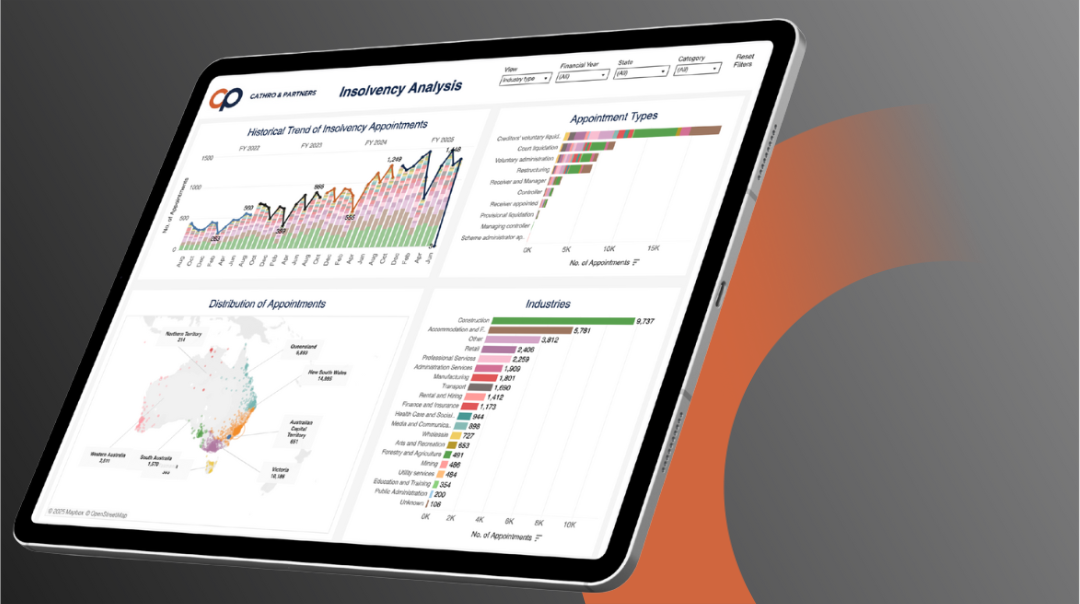As many of you will be aware, on 28 September 2022, the Parliamentary Joint Committee on Corporations and Financial Services began an inquiry into corporate insolvency in Australia and on 12 July 2023, they handed down their report in relation to their findings.
Cathro and Partners Principal, Andrew Blundell, as a member of both the Australian Credit Forum (ACF) and the Australian Institute of Credit Managers (AICM) provided input into both the ACF and AICM submissions and attended the public hearings in support of Anna Taylor (ACF/Results Legal), Grant Morris (Southern Steel Group/ACF/AICM) and Nick Pilavidis (AICM) whom were chosen to provide real life context to these submissions to the parliamentary committee as part of the process. The report reflects several of the points raised in these submissions.
One of the overriding key recommendations from the report was for the Government to commission a comprehensive and independent review of Australia’s insolvency law, encompassing both corporate and personal insolvency overall.
This is an extensive undertaking and will take considerable effort over a substancial period of time to complete and may result in significant changes to the way the insolvency regime operates in Australia.
The committee recommended that those involved with this comprehensive and independent review, once commissioned by the government;
- Consider and report on the appropriate principles and objectives of insolvency law. The committee further recommends that the government respond quickly to this first report to allow the comprehensive review to continue with further stages of work in a timely way.
- Consider and make recommendations on options to enhance public interest objectives and the effectiveness of, and interaction between, the personal and corporate insolvency systems.
- Consult data holders, researchers, industry participants, and public sector organisations to progress the access to and analysis of insolvency data.
- Consider and report on the current system of corporate insolvency pathways from a holistic systems analysis perspective.
- Review the voluntary administration pathway and members voluntary liquidation pathway.
- Consider the requirements for the registration of small business restructuring practitioners to understand the reasons for the limited number of registrations to date.
- Include consideration of the remuneration of insolvency practitioners in relation to:
- the extent to which public interest work carried out by liquidators for no or limited pay is sustainable; and
- the impact of this on all stakeholders in external administrations.
- Include consideration of the operation, efficacy, and efficiency of the current independence requirements for insolvency practitioners, including:
- whether the current requirements are achieving the policy settings that inform them and whether these policy settings are optimal; and
- the advantages and disadvantages of formally separating the roles of advice and restructuring from formal appointments to liquidations and administrations.
- Consider the nature and extent of the harm posed by ‘untrustworthy pre-insolvency advisors’, and whether further regulation or enforcement measures are needed to address this issue. The committee further recommends that in the interim, the government take prompt action to improve the regulation and active enforcement of pre-insolvency advisers.
- Consider and make recommendations on options for funding the administrations of assetless companies, including reforms to the Assetless Administration Fund and the merits of creating a public liquidator for corporate insolvency.
- Consider whether the current statutory reporting obligations for insolvency practitioners are best serving the integrity, efficiency, and efficacy of the Australian corporate insolvency framework, including (but not limited to):
- the ability of the Australian Securities and Investments Commission (ASIC) to appropriately process, utilise and respond to initial statutory reports on current resources; and
- the appropriateness of existing reporting thresholds, having regard to their regulatory value as well as the burden imposed on insolvency practitioners.
- That in the interim, the government and ASIC consider whether any timely changes can be made to the regulations on reporting thresholds, and ASIC’s response to insolvency practitioner reports.
- Examine the operation of the insolvent trading regime and its impact on the broader corporate insolvency framework.
- Analyse and make recommendations on the overall economic and social benefits and costs of Australian Taxation Office relief to potentially insolvent companies in hard economic times, in the context of the impacts on the purposes of the insolvency system.
- Consider the relative priority of employees, liquidators, and secured creditors, including the priority over circulating assets under section 561 of the Corporations Act 2001. The committee further recommends that this be a high priority topic for the comprehensive review.
- Consider and report on franchising insolvency issues.
- Consider unfair preferences and voidable transactions as a core aspect of potential insolvency reform.
Additional recommendations:
On top of the recommendations that would form part of the comprehensive review, should it be commissioned by the Government, the committee recommended that the following additional areas be addressed in the interim as follows:
- That the Australian Securities and Investments Commission collect high quality, granular data in relation to insolvency and provide this data in a timely way to relevant government agencies and regulators.
- That the government implement recommendations from the Safe Harbor Review, independent and likely in advance of the further review, and consider referring the remainder of safe harbour reform issues identified in this report to a comprehensive review.
- That as soon as practicable the government consider and consult on potential reforms to the:
- small business restructuring pathway; and
- simplified liquidation pathway
- That the Australian Securities and Investments Commission collect and analyse data from an appropriately sized sample of voluntary and compulsory deregistrations, to provide greater visibility of the solvency status of deregistered companies.
- That the government reform the experience eligibility requirements for registered liquidators, to address the inequity of the requirements and the gender imbalance in the population of registered liquidators. Reforms could potentially include:
- increasing the period over which experience is demonstrated, or
- replacing part of the required hours with a competency-based exam
- That the government consider changes to the Assetless Administration Fund to ensure that it is achieving its intended policy objectives.
- That the Department of the Treasury consider assessing the potential benefit of the Public Interest Administration Fund proposed by the Productivity Commission in 2015, including the impacts of the required increase on the annual review fee for company renewals; and either consider implementing the proposal, or provide that analysis to a comprehensive review.
- That the Australian Taxation Office consult, act on and publish model creditor guidelines, consistent with its model litigant obligations.
- That the government develop reforms to improve the framework designed to ensure the policy objective of access to the Fair Entitlements Guarantee as a scheme of last resort, both to prevent misuse by novel schemes of arrangement, phoenixing, and other practices and to ensure capture of all individuals with valid entitlements.
- That the government provide a formal response to the Whittaker Review which was completed in 2015.
- That the government amends the Corporations Act 2001 to expressly clarify the treatment of trusts with corporate trustees during insolvency.
Given the substantiveness of the recommendations provided by the committee, we will be providing a breakdown of the recommendations and our thoughts in relation to them over the next four thought leadership articles.
This report may result in a monumental shift in the way corporate and personal insolvency circumstances are addressed in this country and it will be interesting to see what recommendations the government pick up from the report over the coming months and years.
Further reading:
Issue 2: Insolvency Law Reform – has the time come for seismic change? – Issue 2
Issue 3: Insolvency Law Reform – has the time come for seismic change? – Issue 3
Issue 4: Insolvency Law Reform – Has the time come for seismic change? – Issue 4 (cathropartners.com.au)





